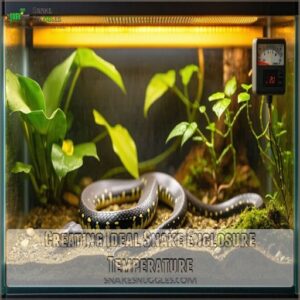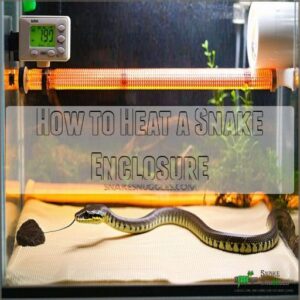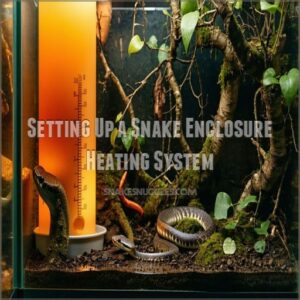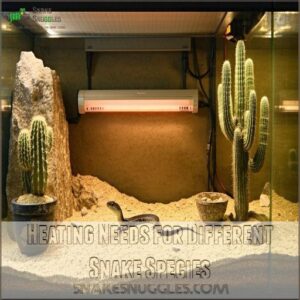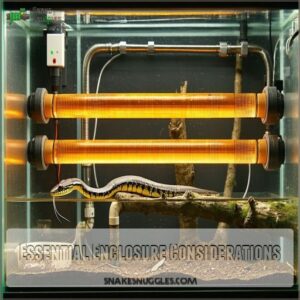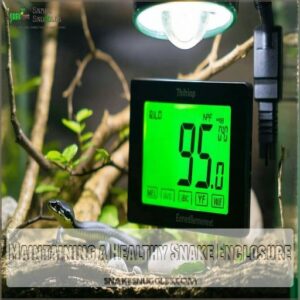This site is supported by our readers. We may earn a commission, at no cost to you, if you purchase through links.
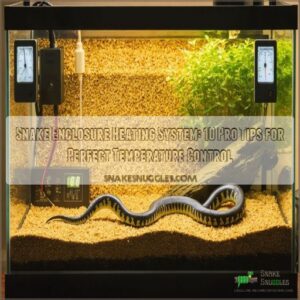
Start with a thermostat-controlled heating pad or ceramic heat emitter as your primary heat source.
Position it to cover 1/3 of the enclosure’s floor space, creating a temperature gradient from 75-95°F (depending on species).
Don’t forget to mount thermometers at both the warm and cool ends to monitor conditions precisely.
Just like you wouldn’t want your home’s heating to go haywire, your snake needs consistent temperature control – and there’s more to it than just slapping on a heat mat and hoping for the best.
Table Of Contents
- Key Takeaways
- Creating Ideal Snake Enclosure Temperature
- How to Heat a Snake Enclosure
- Setting Up a Snake Enclosure Heating System
- Monitoring and Adjusting Temperature
- Top 5 Snake Enclosure Heating Systems
- Heating Needs for Different Snake Species
- Essential Enclosure Considerations
- Beyond Heating: Creating a Comfortable Environment
- Common Mistakes in Snake Enclosure Heating
- Maintaining a Healthy Snake Enclosure
- Frequently Asked Questions (FAQs)
- What Is A Radiant Heat Panel?
- Why Radiant Heat?
- Are the Wilbanks Radiant Heat Panels Easy Too Install?
- Do Wilbanks Radiant Heat Panels Require A Thermostat?
- Can A Radiant Heat Panel Burn My Animal?
- Will I Need To Drill A Hole In My Enclosure To Accommodate The Electrical Cord?
- How Long Will My Wilbanks Advanced Radiant Heat Panel Last?
- Once Installed Can You See The Panel?
- What is the best heating system for a snake enclosure?
- How do I heat my snake enclosure?
- How to keep a snake cage warm at night?
- How to keep a snake warm without electricity?
- What emergency backup heating systems should I have ready?
- How often should heating equipment be replaced?
- Can multiple heat sources interfere with each other?
- Are smart thermostats worth it for snake enclosures?
- What signs indicate a snake is too hot?
- Conclusion
Key Takeaways
- You need to set up a thermostat-controlled heating system with a thermal gradient in your snake’s enclosure, ensuring both warm (80-85°F) and cool (75-80°F) zones.
- Choose heating elements carefully, such as heat mats, ceramic emitters, or heat lamps, based on your snake’s specific habitat needs and use thermostats for precise temperature control.
- Make sure the enclosure has proper ventilation to prevent humidity buildup and risks like scale rot or respiratory issues.
- Regularly monitor and adjust temperatures using thermometers to support your snake’s health, activity, and digestion, being aware that cold stress can lead to issues such as respiratory infections and organ failure, preventing common issues linked to improper heating.
Creating Ideal Snake Enclosure Temperature
You’ll need to create distinct temperature zones in your snake’s enclosure, with a cool side between 75-80°F and a warm side of 80-85°F, to help your pet regulate its body temperature naturally.
temperature gradient that keeps your snake healthy and active.
Your choice of heating equipment, from heat mats to ceramic emitters, will determine how effectively you can maintain this essential temperature gradient that keeps your snake healthy and active.
Understanding Thermal Gradient
Every successful snake enclosure starts with a thermal gradient – think of it as your snake’s personal climate zones.
Just like you might move from the sunny side to the shady side of a room, your snake needs different temperature areas to regulate its body heat.
Creating this gradient isn’t just about comfort; it’s essential for digestion, immune function, and overall well-being.
Choosing The Right Temperature Range
Setting up the right temperature range for your snake isn’t rocket science once you know the basics.
To achieve precise temperature control, consider investing in a high-quality reptile heat lamp, such as those found on Chewy Reptile Heat Lamps, to create a comfortable environment for your pet.
After establishing your thermal gradient, you’ll need to dial in specific temperatures for your scaly friend.
Here’s what to keep in mind for most common pet snakes:
- Basking spot temperature: 88-92°F
- Warm side ambient air: 80-85°F
- Cool side temperature: 75-80°F
- Night temperature drop: 3-5°F lower
Importance of Varied Temperature Zones
Your snake’s health and happiness depend on having distinct temperature zones in their enclosure.
Just like you’d move between sunny and shaded spots on a hot day, snakes need options.
Create multiple zones ranging from 75-85°F to support proper thermal regulation.
This variety lets them naturally adjust their body temperature, digest food efficiently, and maintain a strong immune system.
How to Heat a Snake Enclosure
Smart heating transforms a basic snake enclosure into a cozy habitat that mimics your pet’s natural environment. Think of it like creating a perfect climate-controlled home where your snake can thrive.
To heat your enclosure effectively, you’ll need to understand the basics of heat distribution and equipment selection. When setting up your heating system, be sure to prioritize a thermal gradient setup to allow your snake to regulate its body temperature naturally.
Here’s what you’ll need for a proper heating setup:
- A primary heat source (heat mat, ceramic emitter, or heat lamp)
- A reliable thermostat for temperature regulation
- Multiple thermometers for gradient monitoring
- A heat-resistant mounting system or stand
When selecting heating equipment, consider your snake’s specific needs and natural habitat. When selecting a heat source, it’s essential to consider the specific needs of your snake species, and for ball pythons, best heat lamps for ball pythons with a basking spot temperature of 95-104°F are ideal. Desert species might prefer a ceramic heat emitter, while tropical snakes often do better with heat mats. Remember, the goal isn’t just to warm the space – it’s about creating distinct temperature zones that allow your snake to regulate its body temperature naturally.
Setting Up a Snake Enclosure Heating System
You’ll need to set up your snake’s heating system carefully to create the perfect temperature gradient, with a warm side between 80-85°F and a cool side between 75-80°F.
Getting your heat source placement right is essential, so you’ll want to install thermostats to regulate the temperature and guarantee proper ventilation to prevent dangerous hot spots in the enclosure.
Placement of Heat Elements
When positioning heat elements in your snake’s enclosure, strategic placement is important for their safety and comfort.
Install heat mats under one-third of the tank’s floor, creating a warm zone that your snake can easily access.
Mount ceramic heat emitters or radiant panels at least 12 inches above the substrate to prevent burns, and always use protective barriers around exposed heat sources.
Remember, proper spacing creates an effective thermal gradient without hot spots.
Using Thermostats for Temperature Control
A reliable thermostat acts like your snake’s personal temperature bodyguard.
After setting up your heat elements, connect them to a thermostat to maintain precise control over your pet’s environment.
Here’s what makes a thermostat system work:
- Choose a proportional thermostat for smoother temperature shifts
- Place probes away from direct heat sources
- Calibrate settings during initial setup
- Test accuracy with separate thermometers
Ensuring Good Ventilation
Proper ventilation balances with your thermostat controls to maintain ideal temperatures throughout the enclosure.
To prevent respiratory infections, it’s important to achieve optimal ventilation rates.
Install mesh panels or drilled holes at both low and high points to create natural airflow patterns.
A small USB fan can help circulate air, preventing hot spots and stagnant zones.
Remember to position ventilation away from your snake’s favorite spots to avoid drafts affecting their comfort zone.
Monitoring and Adjusting Temperature
You’ll need accurate temperature readings from multiple spots in your snake’s enclosure to maintain the ideal thermal gradient that keeps your pet healthy and active.
Getting these measurements right isn’t just about comfort – it’s essential for your snake’s digestion, immune system, and overall well-being.
Using Thermometers and Hygrometers
Monitoring your snake’s enclosure temperatures demands reliable tools and consistent attention.
You’ll need two key instruments: a high-quality digital thermometer to track temperature zones and a hygrometer to measure humidity levels.
Place thermometers at both the warm and cool ends of the enclosure, and position your hygrometer in the middle.
Regular checks help make sure your readings stay accurate through calibration every few months.
Adjusting Temperature for Life Stage
Young snakes typically need warmer temperatures than adults to support their rapid growth and metabolism.
Basking Spot Temperature
You’ll want to keep the basking spot 2-3°F higher for juveniles compared to adults of the same species. For example, while adult corn snakes thrive with an 85°F basking spot, babies do better at 87-88°F. Just remember to gradually lower the temperature as they mature.
Breeding Temperature Considerations
After fine-tuning temperatures for different life stages, let’s talk breeding – it’s a whole different ball game.
Breeding season requires mimicking natural hibernation cues.
Gradually lower temperatures 5-10°F below normal for 2-3 months.
Once breeding begins, slowly raise temperatures back to the best breeding range.
This temperature cycling triggers natural reproductive behaviors in most snake species.
Top 5 Snake Enclosure Heating Systems
You’ll find the perfect heating solution for your snake’s home among these top-rated systems that combine reliability with precise temperature control.
These five heating options will help you maintain the ideal thermal environment your scaly friend needs to thrive.
Whether you’re a first-time snake owner or an experienced keeper.
1. Hermit Crab Heat Mat Reptile Heating Pad
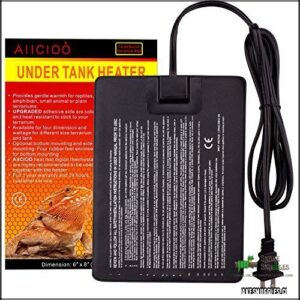
When setting up your snake’s heating system, the Aiicioo Hermit Crab Heat Mat stands out as a versatile solution.
This 16-watt pad covers an 8" x 12" area, perfect for 30-40 gallon tanks.
You’ll appreciate its upgraded adhesive material and uniform heat distribution, eliminating dangerous hot spots.
To make sure you get the right temperature, consider matching the heating pad size to your terrarium to create a suitable thermal gradient.
Mount it underneath or on the tank’s side using the included rubber feet for proper ventilation.
While it lacks adjustable settings, its nichrome heating wire provides consistent warmth.
Just remember: never place it on flammable surfaces or cover it with substrate.
Best For: This heating pad is ideal for smaller reptile tanks, especially those housing species that prefer warmer temperatures.
- Provides consistent and uniform heat distribution, minimizing hot spots.
- Durable construction with nichrome heating wire makes it easy to clean and wipe.
- Versatile mounting options allow for placement underneath or on the side of the tank.
- Does not have adjustable heat settings.
- May not be sufficient for larger tanks.
- Some users have reported that it’s not as effective as expected.
2. Reptile Heat Pad 8×12 Inch 16W
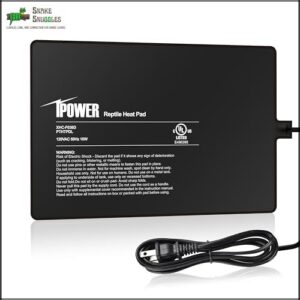
The iPower Reptile Heat Pad offers reliable bottom heating with its advanced PTC technology and 3M adhesive backing.
You’ll appreciate how quickly it reaches the right temperature while maintaining energy efficiency.
At 8×12 inches with 16 watts of power, it’s perfect for small to medium-sized enclosures.
The waterproof design and 6-foot cord provide flexibility in placement, though you can’t move it once installed.
While it works great for most reptiles, consider adding a protective layer between the pad and substrate to prevent direct contact with your snake.
Best For: The iPower Reptile Heat Pad is best for owners of small to medium-sized reptiles and other small animals.
- Heats up quickly and evenly.
- Provides a warm spot for reptiles and other small animals.
- Durable and long-lasting.
- Some users report issues with temperature control.
- May not be suitable for large tanks.
- Adhesive may not be compatible with all surfaces.
3. Reptile Heat Mat Thermostat
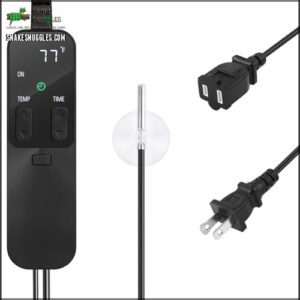
Precision-controlled heating transforms your reptile’s habitat with this smart thermostat.
You’ll love how it maintains temperatures within 1°F using PID technology, preventing those worrying fluctuations that could stress your snake.
The user-friendly interface features simple UP/DOWN buttons and a convenient auto-off timer with 2-12 hour settings.
It’s energy-efficient too, automatically dimming power output to maintain steady temperatures.
While some users note a slight buzzing sound in standby mode, the flame-retardant construction and power-saving features make this thermostat a reliable choice for your scaled friend’s comfort.
Best For: This thermostat is ideal for reptile owners who need precise temperature control for their pets.
- Maintains stable temperatures within 1°F, minimizing fluctuations.
- Easy-to-use interface with simple buttons and a convenient auto-off timer.
- Energy-efficient design with dimming feature for power savings.
- Some users report a buzzing sound in standby mode.
- The suction cup attachment may not be reliable.
- A whirring sound from the controller has been reported by some users.
4. Reptile Heat Pad with Thermostat
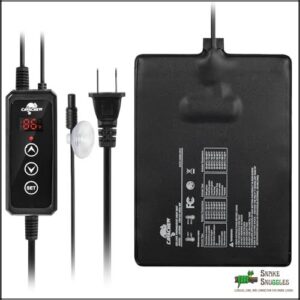
Smart temperature control meets reliable heating in this innovative reptile heat pad system.
You’ll appreciate the carbon film heating material that distributes warmth evenly throughout your snake’s enclosure.
The dual thermostat protection, featuring a built-in 122°F control chip and external adjustable thermostat, keeps your pet safe while maintaining precise temperatures.
Its PID smart thermostat lets you dial in exact temperatures between 68°F and 122°F.
The 68-inch pad works perfectly for 10-20 gallon terrariums, while the high-toughness PVC construction guarantees lasting durability and excellent insulation.
Best For: This heat pad is best for reptile owners who want a safe and easy way to provide a consistent temperature for their pets in smaller enclosures.
- Even heat distribution thanks to carbon film heating material
- Precise temperature control with dual thermostat protection and PID smart thermostat
- Easy installation with adhesive backing
- May require multiple mats for larger tanks
- Adhesive may be difficult to remove
- Some users reported uneven heating and difficulty achieving desired temperature
5. Zoo Med Repticare Rock Heater
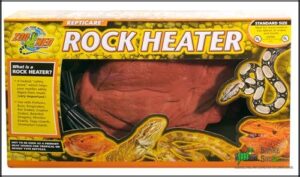
Looking for a natural-looking heat source that doubles as decor? Zoo Med’s Repticare Rock Heater offers a clever solution.
This heated safety stone blends seamlessly into your snake’s habitat while providing consistent warmth.
You’ll appreciate its durability and affordability compared to traditional options.
While it runs slightly warmer than advertised, pairing it with a reliable thermometer makes sure the temperature is just right.
Just remember to position it strategically, leaving plenty of cool spots for your snake to thermoregulate.
Pro tip: Choose the size carefully – the large version might surprise you with its dimensions.
Best For: Reptile owners seeking a natural-looking, affordable, and durable heat source.
- Provides consistent warmth.
- Blends seamlessly into terrarium decor.
- Durable and affordable.
- Runs slightly warmer than advertised.
- Large size is significantly larger than the medium size.
- Requires careful temperature monitoring.
Heating Needs for Different Snake Species
You’ll need to match your snake’s heating setup to its natural habitat since desert species like ceramic heat emitters while tropical snakes prefer heat mats and basking lamps.
Your snake’s specific temperature requirements will guide your choice of heating equipment, with corn snakes needing 70-85°F ranges and ball pythons requiring warmer 80-92°F zones.
Corn Snakes and Ball Pythons
Understanding your corn snake or ball python’s specific heating needs, including the fact that ball pythons can endure up to 6 hours at 75°F before adverse effects start appearing due to cold exposure risks, can make the difference between a thriving pet and a stressed one.
Both species require distinct temperature zones, but they’ll need different ranges to stay healthy.
- Corn snakes thrive with a warm side at 85°F and cool side at 75°F
- Ball pythons need slightly warmer temps: 88-92°F basking spot
- Heat mats work great for both species
- Monitor temps with two thermometers
- Use a thermostat to prevent overheating
Tropical and Temperate Snakes
Tropical and temperate snakes need different heating setups than their corn snake and ball python cousins. Ball pythons, for instance, require a temperature gradient, such as a basking area temperature range, to thrive in their environment. Tropical and temperate snakes need different heating setups than their corn snake and ball python cousins.
Tropical pets, like tree boas and rainbow boas, thrive with heat mats and basking lamps maintaining 75-85°F.
Keep humidity high at 70-80%.
Temperate species like rat snakes and kingsnakes prefer a cooler range of 70-80°F with lower humidity around 50-60%.
Both groups benefit from UVB lighting.
Desert Snakes and Their Heating Requirements
Desert snakes bring their own set of heating challenges, adapting from scorching days to cool nights.
For these unique reptiles, you’ll need to recreate their natural environment with specific heat sources:
- Ceramic heat emitters, which maintain a consistent temperature without light emission and are available in various wattages to suit different enclosure sizes, like those for boa constrictors, work best for nighttime warmth without disrupting sleep cycles
- Daytime basking spots should reach 95-100°F using heat lamps
- Keep humidity low (30-40%) while maintaining proper ventilation
Watch your desert friend’s behavior – they’ll show you if the temperature’s right.
Essential Enclosure Considerations
You’ll need to think about more than just heating when setting up your snake’s home, including the right size, substrate choice, and lighting setup.
A proper heating system forms the foundation of your enclosure.
These additional factors work together to create a comfortable and healthy environment where your snake can thrive.
Size and Spaciousness
The right-sized enclosure lets your snake move freely between temperature zones.
For the best heating control, provide an enclosure that’s at least two-thirds your snake’s length, with extra width for proper heat gradient setup.
A 4-foot snake needs at least a 30-gallon tank to maintain distinct warm and cool areas.
Remember: a cramped snake can’t properly thermoregulate, affecting its health and comfort.
Choosing The Right Substrate
Selecting the right substrate for your snake’s enclosure is like choosing the perfect foundation for a home. You’ll want something that balances safety, cleanliness, and comfort while supporting proper temperature distribution. To make sure you have the right temperature, consider complementing your substrate choice with a reptile heating pad from a trusted supplier like reptile heating solutions.
- Aspen shavings provide excellent burrowing opportunities and maintain heat well
- Coconut husk offers natural antimicrobial properties and great insulation
- Reptile carpet is easy to clean and maintains consistent temperatures
- Newspaper works well for quarantine and is cost-effective
- Bio-active substrates create a natural ecosystem and help regulate temperature
Lighting and Humidity Considerations
Inside your snake’s enclosure, proper lighting and humidity work together to create a healthy environment.
You’ll want UVB lighting for vitamin D synthesis, running on a natural day/night cycle.
Keep humidity levels between 60-80% using misting systems or moisture-retaining substrates.
Install proper ventilation to prevent humidity buildup, and use hygrometers to monitor moisture levels consistently.
Your basking bulbs should create warm spots without overheating the space.
Beyond Heating: Creating a Comfortable Environment
You’ll need more than just the right temperature to keep your snake happy and healthy in its enclosure.
A well-designed habitat includes hiding spots, proper humidity control, and good airflow that work together with your heating system to create an environment where your snake can thrive.
Providing Hiding Places and Enrichment
Your snake’s enclosure needs more than just the right temperature – it needs engaging spaces that make them feel secure and stimulated.
Consider incorporating a boa constrictor enclosure size guide to make sure the space is well-suited for your snake’s growth.
Add cork bark tunnels and natural branches for climbing, creating multiple hiding spots at different heights.
Mix in some safe artificial plants and rocks for environmental enrichment.
These additions help reduce stress and encourage natural behaviors like exploring, climbing, and hunting.
Maintaining Proper Humidity Levels
After setting up those cozy hiding spots, let’s talk about keeping the right amount of moisture in your snake’s home. Maintaining proper humidity levels is like running a spa for your serpent – it helps with shedding, respiratory health, and overall comfort.
- Place large water bowls near heat sources to boost humidity naturally
- Use moisture-retaining substrates like coconut husk or moss
- Install an automatic misting system for consistent moisture levels
- Monitor humidity with digital hygrometers in multiple spots
Ensuring Good Air Quality
While maintaining proper temperature is essential, good air quality plays an equally important role in your snake’s health.
Install ventilation holes or mesh panels to promote consistent airflow, preventing dangerous mold growth and stagnant air pockets.
Position these openings strategically – lower ones for cool air intake and upper ones for warm air exit.
Monitor humidity levels regularly, as proper ventilation helps regulate moisture without creating uncomfortable drafts.
Common Mistakes in Snake Enclosure Heating
You’ll find that setting up your snake’s heating system isn’t rocket science, but even experienced keepers make key mistakes that can affect their reptile’s health.
Whether you’re dealing with improper temperature gradients or incorrect heat source placement, understanding these common pitfalls will help you create the perfect thermal environment for your scaly friend.
Insufficient Temperature Gradient
Creating a cozy space for your snake goes beyond basic heating.
Setting up an incorrect temperature gradient is like giving your snake a one-size-fits-all sweater – it just doesn’t work.
For example, consider investing in a reliable snake heat mat to provide a consistent heat source.
Many owners make the mistake of providing uniform heat throughout the enclosure.
This prevents natural thermoregulation, causing stress and potential health issues.
Your snake needs distinct warm and cool zones to thrive.
Inadequate Ventilation
Everyone underestimates proper ventilation in snake enclosures, but it’s essential for preventing health issues.
Without adequate airflow, you’re risking mold growth and respiratory problems in your snake.
Here’s what poor ventilation can cause:
- Excessive humidity buildup leading to scale rot
- Dangerous heat stress from trapped warm air
- Growth of harmful bacteria and mold colonies
- Respiratory infections from stagnant air conditions
Ensure your enclosure has proper air circulation through strategically placed vents.
Incorrect Heat Source Placement
Your heat source‘s location can make or break your snake’s comfort and safety.
Unlike ventilation issues, incorrect placement often leads to direct harm.
Creating a proper heat gradient in the enclosure is essential for thermoregulation, but you’ll want to avoid putting heat mats on the sides of tanks (they belong underneath), and don’t mount heat lamps too close to your snake’s basking spot.
Position heat sources to create proper temperature gradients across the enclosure.
Maintaining a Healthy Snake Enclosure
You’ll need to create a thermal gradient in your snake’s enclosure, with a cool side between 75-80°F and a warm side of 80-85°F, using a thermal gradient setup. You’ll need to monitor your snake’s enclosure temperature daily and maintain proper heating levels to make sure your reptilian friend stays healthy and active.
Regular cleaning schedules and quick temperature adjustments will help prevent health issues while keeping your snake comfortable in its carefully controlled environment.
Regular Temperature Checks
After setting up the perfect heating system, daily temperature monitoring becomes your next defense against mishaps.
Keep an accurate thermometer at each end of the enclosure, checking readings twice daily.
Smart keepers maintain a temperature log – it’s like a diary for your snake’s comfort.
Digital thermometers with alarm systems can alert you to dangerous fluctuations, giving peace of mind when you’re away.
Cleaning and Maintaining The Enclosure
Keeping a snake enclosure spotless goes hand-in-hand with temperature monitoring.
Clean substrates and proper maintenance create the perfect environment for your scaly friend.
Here’s what you need to tackle weekly:
- Replace substrate when it’s soiled or damp
- Sanitize water bowls with reptile-safe cleaner
- Wipe down enclosure walls and heating elements
- Remove waste and uneaten food promptly
Remember, a clean enclosure means your heat panels and thermostats work more efficiently.
Monitoring Snake Health
Regular health checks let you spot issues before they become serious problems.
Watch for unusual behaviors like excessive soaking or avoiding warm spots – these could signal temperature problems.
Monitor weight monthly, track feeding responses, and document complete sheds.
A healthy snake actively explores its environment and maintains consistent eating patterns.
Take notes on fecal matter appearance and frequency to catch potential health concerns early.
Frequently Asked Questions (FAQs)
What Is A Radiant Heat Panel?
A radiant heat panel is your enclosure’s ceiling-mounted heating solution that emits infrared heat evenly across the space below. It’s energy-efficient and won’t create dangerous hot spots like traditional bulbs.
Why Radiant Heat?
You’ll love how radiant heat panels evenly distribute warmth from above, just like natural sunlight. They’re efficient, safe, and won’t burn your pet while maintaining consistent temperatures throughout the enclosure.
Are the Wilbanks Radiant Heat Panels Easy Too Install?
Wilbanks radiant heat panels are generally easy to install. Their straightforward design minimizes setup hassle. You’ll find clear instructions included; installation shouldn’t be a problem.
Do Wilbanks Radiant Heat Panels Require A Thermostat?
Ever wonder if those Wilbanks Radiant Heat Panels need a thermostat?
They sure do!
A thermostat‘s key to maintaining a stable, safe temperature for your snake, preventing overheating and ensuring your pet’s habitat stays just right.
Can A Radiant Heat Panel Burn My Animal?
Radiant heat panels can burn your animal if improperly installed or lacking a thermostat.
Make sure you place them safely, maintain adequate distance, and use a thermostat to regulate temperature, preventing overheating and ensuring your pet’s safety and comfort.
Will I Need To Drill A Hole In My Enclosure To Accommodate The Electrical Cord?
Think of your enclosure as a puzzle with cords as puzzle pieces.
You might need to drill a small hole to accommodate the electrical cord, ensuring a snug fit to maintain your snake’s safety and enclosure integrity.
How Long Will My Wilbanks Advanced Radiant Heat Panel Last?
Your Wilbanks Advanced Radiant Heat Panel typically lasts over five years with proper use and care.
Regular maintenance, like dusting and checking for wear, keeps it running smoothly, ensuring your snake stays cozy without unwanted surprises.
Once Installed Can You See The Panel?
Once installed, the panel usually blends seamlessly with the enclosure’s ceiling, staying out of sight.
You might notice its presence only when you peek closely, ensuring no drastic clash with your setup’s natural aesthetics.
What is the best heating system for a snake enclosure?
About 95% of snake health issues stem from inadequate heating.
For your snake enclosure, consider using heat pads or ceramic emitters for best gradient control, paired with thermostats for precise temperature regulation, ensuring a snug and safe environment.
How do I heat my snake enclosure?
Maintaining the right temperature‘s key for your snake’s health.
Use a heat mat, panel, or emitter; a thermostat helps.
Monitor temps with a thermometer, ensuring a warm and cool side.
Adjust based on your snake’s needs.
How to keep a snake cage warm at night?
Getting a snake’s cage toasty at night is like crafting the perfect bedtime story.
Ceramic heat emitters or radiant heat panels provide gentle, consistent warmth without light, ensuring your slithery friend snoozes comfortably.
How to keep a snake warm without electricity?
Use insulated boxes with heat packs to keep your snake warm without electricity.
Make sure there’s good ventilation and temperature monitoring.
Consider thermal blankets or hot water bottles, but always prioritize safety to avoid overheating or burns.
What emergency backup heating systems should I have ready?
Consider a battery-powered heat mat, solar-powered heat lamps, and insulated blankets for emergencies.
Each backup offers peace of mind and flexibility, ensuring your snake’s comfort during power outages or unexpected cold snaps.
Stay ready, stay prepared.
How often should heating equipment be replaced?
Replace heating equipment every two to three years, or sooner if there are signs of wear and malfunction.
Regular checks prevent failures.
Maintaining a safe and cozy environment for your snake is essential for its comfort and health.
Can multiple heat sources interfere with each other?
Multiple heat sources can interfere if not balanced properly, potentially causing temperature spikes or dips.
Use thermostats to manage each source, ensuring they complement one another and create a consistent thermal gradient for your snake’s well-being.
Are smart thermostats worth it for snake enclosures?
Smart thermostats are worth it for snake enclosures, offering precise temperature control to maintain the ideal thermal gradient.
They prevent overheating or cold spots, ensuring your snake stays comfy and healthy.
Plus, they save you energy!
What signs indicate a snake is too hot?
Is your snake lethargic, gaping its mouth, or excessively shedding? These could mean it’s overheating. Seek a vet if you see these signs. A cool, shaded spot might help.
Conclusion
Did you know that 80% of snake health issues are linked to improper heating?
A well-designed snake enclosure heating system keeps your scaly friend comfy and prevents common health problems.
By mastering temperature gradients, using a thermostat, and placing heat sources wisely, you’re ensuring a healthy environment.
Regular checks and adjustments tailor the setup to your snake’s needs, creating a haven that’s both safe and cozy.
Keep your snakes thriving with these essential heating tips.

